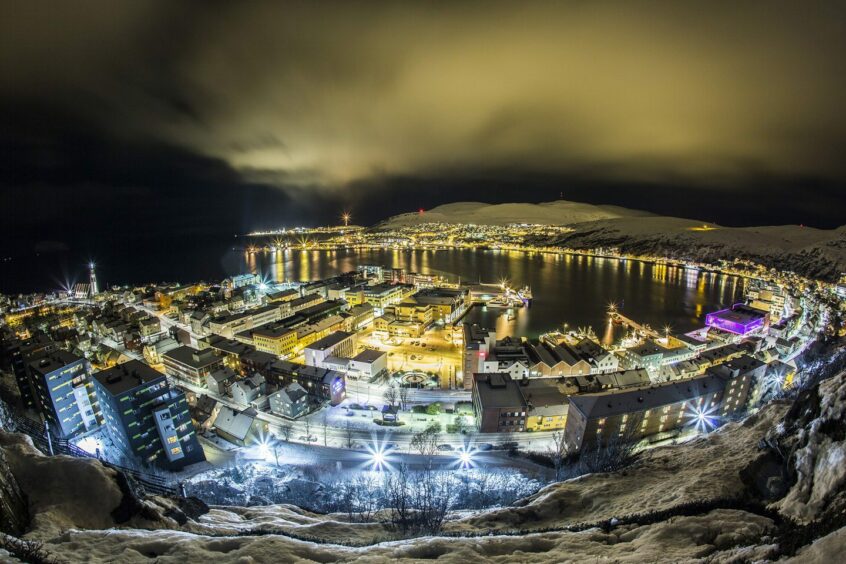
The Municipality and Port of Hammerfest is ready to take centre stage in the next phase of the generations-long relationship between the north-east of Scotland and Norway by sending its largest ever delegation to ONS.
With a common history as fishing towns which evolved to welcome their respective energy industries, Aberdeen and Hammerfest already have plenty in common in terms of innovation and evolving in step with the world around them – in 1891 Hammerfest became the first settlement in northern Europe to benefit from electric streetlights and it has not looked back since.
Now, as the Arctic Norway Energy Centre the latest chapter in the story took the form of the signing of a MOU by the Lord Provost of Aberdeen and the Mayor of Hammerfest, setting the scene for the energy transition and net zero journey – and further exploring the wealth of opportunities both locations have to offer.
Exciting times in the area include the development of Polaris, a carbon capture and storage project off the coast with a total carbon storage capacity of more than 100 million tonnes, or twice Norway’s annual ghg emissions. This is a crucial part of Horisont Energy AS’s Barents Blue project, a large-scale, carbon neutral production facility for blue ammonia located in Hammerfest Municipality which will be capable of producing 3000 tonnes of ammonia per day. This will use natural gas from offshore fields that would otherwise be turned into LNG or flared as there are no pipelines connecting the Barents Sea to the network further south.
Carbon Capture is not new to Hammerfest – since 2008, the Snøhvit facility on Melkøya has been separating CO2 from the well stream before the gas is chilled to produce liquefied natural gas (LNG). The CO2 is transported back to the Snøhvit field by pipeline and injected into a subsea formation. During normal operations, up to 700,000 tonnes of CO2 a year is stored here.
Hammerfest Municipality is in Finnmark County, the northernmost county in Norway and the most suited to onshore wind, and some of the energy produced is converted to green hydrogen through electrolyses. Larger scale developments of this nature may be possible in the future.
In Hammerfest itself, several projects have joined together to become the Hammerfest Clean Harbour Project which maximises significant synergies between stakeholders to facilitate important environmental infrastructure and urban development project which develops the economic base in Hammerfest harbour; fulfils a national action plan to clean up the seabed; improves maritime safety and creates further business development opportunities in and around Hammerfest.
The Port Authorities have also invested in a renewable power network for the visiting fleet of fishing vessels and larger vessels, avoiding the use of diesel generators or main engines on board when visiting the port. The network is also available for charging boats and ships which have been converted to electric propulsion.
To support the energy transition, one of Europe’s largest deposits of copper is being developed within the borders of Hammerfest Municipality.
Nussir ASA’s project will be a state-of-the-art mine and is planned to be the first fully electrified in the world. Once in commercial operation from 2024, there will be no diesel engines on site, and with the Finnmark electrical grid carrying 100% renewable energy, mostly from hydropower, but also wind. Mining and transport machinery will all be electric making this a truly clean environment also for the workers of the mine itself.
Commenting on hopes for ONS and beyond, Special Advisor to Hammerfest Municipality and Port Bjørn Storvik said: “We sit at the heart of an exciting place and time for the Norwegian energy transition journey and it is very important we get out there to tell the world what’s happening here in Hammerfest, and to find out what learning we can take home from other places to build on.
“The absence of events such as ONS has been felt very much and in many ways, especially when it comes to taking our message across the North Sea to our friends in Scotland and learning from their experiences.
“There are so many examples of Aberdeen and Hammerfest working together and learning from each other in the past and these will continue as we share knowledge about what the future might look like for our home cities, which are so similar in many ways.”
To find out more, visit http://www.hammerfesthavn.no/
